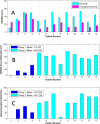First experience with MR-guided focused ultrasound in the treatment of Parkinson's disease
- PMID: 25512869
- PMCID: PMC4266014
- DOI: 10.1186/2050-5736-2-11
First experience with MR-guided focused ultrasound in the treatment of Parkinson's disease
Abstract
Background: Radiofrequency (RF) subthalamotomies have been proposed since the 1960s to treat patients suffering from Parkinson's disease (PD). Recently, the magnetic resonance (MR)-guided focused ultrasound technology (MRgFUS) offers the possibility to perform subthalamic thermocoagulations with reduced risks and optimized accuracy. We describe here the initial results of the MRgFUS pallidothalamic tractotomy (PTT), an anatomical and physiological update of the earlier subthalamotomies.
Methods: Thirteen consecutive patients suffering from chronic (mean disease duration 9.7 years) and therapy-resistant PD were treated unilaterally with an MRgFUS PTT. Primary relief assessment indicators were the score reduction of the Unified Parkinson Disease Rating Scale (UPDRS) and the patient estimation of global symptom relief (GSR) taken at 3 months follow-up. Final temperatures at target were between 52°C and 59°C. The MR examinations were performed before the treatment, 2 days and 3 months after it. The accuracy of the targeting was calculated on 2 days post-treatment MR pictures for each PTT lesion.
Results: The first four patients received a PTT using the lesional parameters applied for thalamotomies. They experienced clear-cut recurrences at 3 months (mean UPDRS relief 7.6%, mean GSR 22.5%), and their MR showed no sign of thermal lesion in T2-weighted (T2w) images. As a consequence, the treatment protocol was adapted for the following nine patients by applying repetition of the final temperatures 4 to 5 times. That produced thermocoagulations of larger volumes (172 mm(3) against 83 mm(3) for the first four patients), which remained visible at 3 months on T2w images. These nine patients enjoyed a mean UPDRS reduction of 60.9% and a GSR of 56.7%, very close to the results obtained with radiofrequency lesioning. The targeting accuracy for the whole patient group was 0.5, 0.5, and 0.6 mm for the anteroposterior (AP), mediolateral (ML), and dorsoventral (DV) dimensions, respectively.
Conclusions: This study demonstrated the feasibility, safety, and accuracy of the MRgFUS PTT. To obtain similar results as the ones of RF PTT, it was necessary to integrate the fact that white matter, in this case, the pallidothalamic tract, requires repeated thermal exposition to achieve full lesioning and thus full therapeutic effect.
Figures





References
LinkOut - more resources
Full Text Sources
Other Literature Sources
Research Materials

